Caspian Gull at Rosekiln Lane, Reading
10 Feb 2003 | Paul Bright-Thomas
Caspian Gull 1st Winter
Larus argentatus/cachinnans cachinnans
A33/Rose Kiln Lane Floods 14:40-15:20 7th February 2003
Viewed at approximately 100m (30x Swarovski scope).
Still present when observer departed.
Weather: Dull, cloudy, no wind, very flat light.
Mid-large gull in company with Lesser Black-backed gulls (a few argenteus Herring Gull and Greater Black-backed Gulls also present in nearby flock) and 100-200 Black-headed Gulls, plus at least 10 Common Gull. Slightly larger than adjacent Lesser Black-backed Gulls, but standing distinctly taller, due to longer legs.
Attracted attention due to white head contrasting with sharply defined streaked nape, and pale grey mantle contrasting with warm brown wing coverts/tertials and blackish primaries.
Small-headed with sloping forehead and very flat crown, especially when viewed head-on or from behind. Mostly quite hunched, with small head tucked in. Posture mostly horizontal, but standing in shallow water, so lower, and occasionally whole, tarsus submerged. Slim gull with long primary projection, at least 30% longer than tertials, which were narrow and did not form a step to interrupt profile of back. Walked around, picked things up from marsh, raised wings and flew a short distance.
Striking white head with isolated dark eye; on closer examination fainty greyish smudge around and behind eye, but not as distinct as to form an "eye-patch" as on 1W michahellis. Strong grey longitudinal streaking on nape and neck sides, forming very sharply defined "shawl", projecting onto necksides as dusky streaked triangles; streaks separated by white, forming lines along neck sides. Crown, forehead cheeks, lores, ear coverts, chin throat and breast centre all pure white. Breast sides and belly whitish with smudgy dusky blotches. Vent and undertail coverts mostly pure white, although with widely spaced narrow chocolate barring along edges of undertail area and just reaching onto rear flanks.
Mantle mostly pale grey but many of feather with dark brown shaft streaks. Some feathers appeared to have single transverse brown marking forming cross marking; not apparently a subterminal crescent/anchor, although possibly boundaries of individual feathers a little unclear at distance. A few of smaller mantle feathers with solid brown centres. At least two of rear lower scapulars on each side were solid uniform grey, with no shaft or transverse markings,a nd perhaps a slightly darker grey than the marke dmantle feathers.
Mostly solidly brown lesser and median coverts with narrow whitish edges, making a reasonably strong "shoulder patch when contrasted with greyer mantle/scapulars). Greater coverts warm earthy brown on basal two thirds, narrow white outer edges, slightly broader white tips, no notching or barring. Tertials earth brown with narrow diffuse white tips (no white edges to basal part of feathers). The tertials were perhaps a little more faded and brown than on some birds, and with narrower white tips, suggesting some bleaching and wear. Primaries were dark brownish black, 4/3 as long as tertials, very narrowly pointed, no pale edges or mirrors visible. Tertials darker brown then coverts, and primaries darker in tern than tertials.
Eye dark and appearing small in almost pure-white head. Bill slim and parallel-sided with no thickening towards end and almost no gonydeal angle. Bill tip gently curving and finely pointed, not chunky and abrupt like Herring Gull. Final 1/3 solid black with very tip of upper mandible pale yellowish. Black along cutting edges of both mandibles and nasal groove, but basal 2/3 showing dirty pink bleeding through the basically dark bill on upper and lower culmens and sides of upper mandible. There was no sharp division between the all-dark tip and slightly paler bill base.
Legs long and spindly, pale pink. When standing next to LBBs that were up to their bellies in water, knee of Caspian Gull partially visible and length of tibia also visible keeping belly well-clear of water.
In brief flight, showed dull brown-black primaries and secondaries almost concolourous across remiges, but inner primaries slightly paler on inner webs, forming suggestion of "window". Greater coverts clearly separated from secondaries by narrow pale tips, forming a weak pale bar across wing. The wings appeared distinctly more uniform than in Herring Gull, since there was little contrast across the remiges, or between the remiges and the coverts.
Underwing base appeared very white on axillaries and inner coverts, and also pale on underside of secondaries. No strong brown markings further up wing, although some pale brown feather tips present. Wings long and slim with rather pointed "hand".
Tail had strong black terminal band, with white base and upper tail coverts, with some black marks detached from inner edge of tail band on outer tail feathers.

Fig 1. Field sketch of 1W Caspian Gull 7th February 2003
This is my first sighting of an immature Caspian Gull but I have seen two adults in Berkshire (Feb and Dec 2001), and a probable adult in Jan 2003. I have made a study of a wide range of identification material on Caspian Gull found in journal articles and including many photographs published on the internet.
The bird observed strongly resembled the Caspian Gull shown in the top figure here although the bill colouration was perhaps closer to this bird.
© 2003 Paul Bright-Thomas